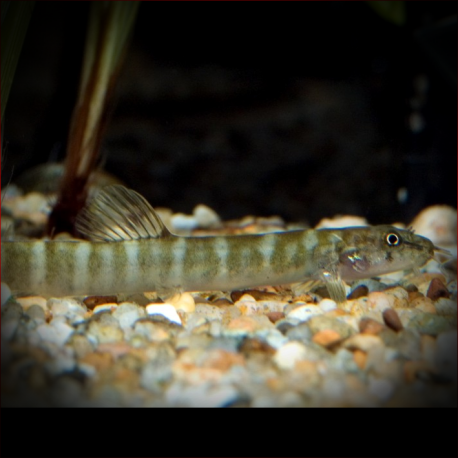More info
Datasheet
| Minimum Tank Size | 60 litres / 15.85 US gallons |
| Maximum Size | 5.5cm / 2.17inches |
| Temperature | 21°C / 69.80°F - 26°C / 78.80°F |
| Hardness | 2.02dgH / 36ppm - 12.05dgH / 215ppm |
| pH | 6.0-7.5 |
General Description
The Aborichthys Sp. 'AR01' is a species of loach often traded as A. elongatus, yet it seems to represent an undescribed taxon with distinct coloration and patterning. Belonging to the family Nemacheilidae, this fish has an elongate body with various unique characteristics such as a black spot at the base of the caudal fin and concentric rings on the tail. Its natural diet consists mainly of insect larvae, worms, crustaceans, and zooplankton. In the aquarium, it is an aggressive feeder and eagerly consumes live and frozen foods.
Aquarium Setup
To maintain the Aborichthys Sp. 'AR01' successfully, it is recommended to set up an environment that mimics a flowing stream or river. A substrate of rocks, sand, and gravel, along with driftwood branches for exploration, is advised. Due to the species' digging behavior, decorative items should be placed on the tank base before adding the substrate. Clean water with high dissolved oxygen levels and good water movement are essential. Although most aquatic plants may struggle, hardy varieties like Java fern, Bolbitis, or Anubias can be attached to the décor.
Behaviour
This species is not notably aggressive but has specific requirements that make it unsuitable for a general community aquarium. It is best kept with species that can tolerate its need for water movement and are not slow-moving or long-finned. Maintaining a group of six or more specimens allows for the observation of amusing interactions, although occasional aggressive behavior may be witnessed.
Feeding and Diet
In its natural habitat, the Aborichthys Sp. 'AR01' primarily feeds on insect larvae, worms, crustaceans, and zooplankton. In an aquarium setting, it eagerly accepts dried foods but should also be provided with regular offerings of small live and frozen fare such as Daphnia, Artemia, and bloodworms. The addition of food to the tank often induces frenzied feeding behavior due to its highly developed sense of taste.
Reproduction & Dimorphism
There are no documented reports of the Aborichthys Sp. 'AR01' reproducing in captivity. Adult females are likely to be fuller-bodied and slightly larger than males, although other differences are yet to be reported.
Habitat and Distribution
Native to the Raidak I River basin in Bhutan and parts of India, this species is typically found in shallow, swiftly-flowing waters with gravel and rock substrate. They do not inhabit areas with aquatic plants but thrive in environments covered in algae, diatoms, and microorganisms. Other species coexisting in the Raidak I include Acanthocobitis botia, Schistura scaturigina, Amblyceps mangois, and others.

